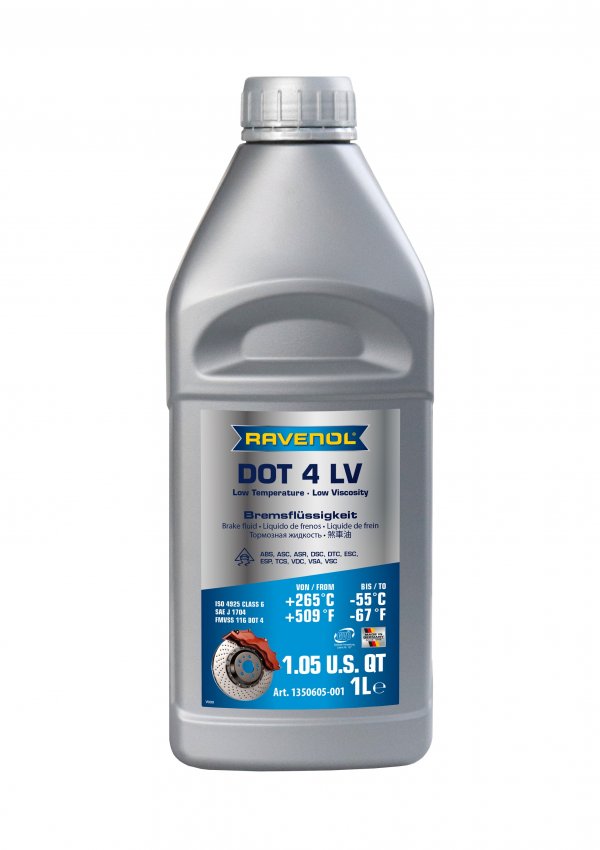RAVENOL DOT 4 LV is a very high specification Brake and Clutch Fluid which conforms to and exceeds the latest ISO 4925 Class 6 standard.
The specific formulation of RAVENOL DOT 4 LV also meets current international specifications US FMVSS 116 DOT 3, DOT 4, SAE J 1703, SAE J 1704 and ISO 4925 (Classes 3 & 4).
With its exceptional viscosity performance even at extremely Low Viskosity (max. 750 cSt @ -40°C) RAVENOL DOT 4 LV is especially recommended for use in the hydraulic brake and clutch systems of vehicles fitted with ESP / ASR (Electronic Stability Program) systems.
The safety potential of the aggregates is enhanced by the excellent properties of RAVENOL DOT 4 LV even at low temperatures.
RAVENOL DOT 4 LV mixes safely with other brake and clutch fluids that meet the above specifications.
Application Note
RAVENOL DOT 4 LV brake fluid can be used in all vehicles where ISO 4925 Class 6 specification is required.
RAVENOL DOT 4 LV is recommended for use in the hydraulic brake and clutch systems of vehicles fitted with ESP / ASR (Electronic Stability Program) systems.
RAVENOL DOT 4 LV is also recommended for use in the hydraulic brake and clutch systems of all cars, commercial vehicles and motorcycles for which a non-petroleum based fluid of this type is specified.
RAVENOL DOT 4 LV brake fluid is miscible with all known brake fluids of the same specification.
To use the high performance level of RAVENOL DOT 4 LV, a complete change of the brake fluid is recommended.
RAVENOL DOT 4 LV is not suitable for vehicles with mineral oil systems (e.g. certain Citroën models).
FOLLOW VEHICLE MANUFACTURERS RECOMMENDATIONS WHEN ADDING BRAKE FLUID KEEP BRAKE FLUID CLEAN AND DRY. Contamination with dirt, water, petroleum products or other materials may result in brake failure or costly repairs.
STORE BRAKE FLUID ONLY IN ITS ORIGINAL CONTAINER. KEEP CONTAINER CLEAN AND TIGHTLY CLOSED TO PREVENT ADSORPTION OF WATER. CAUTION! DO NOT REFILL CONTAINER AND DO NOT USE FOR OTHER LIQUIDS.
Dispose of used brake fluid responsibly (EU waste code 160113)Brake fluid damages paint work –if spilt wash off immediately with plenty of water.
Characteristics
- Fluidity even at very low temperatures
- Optimal ABS properties.
- Chemical stability.
- High lubricating power
- Neutral behavior towards brake parts.
- Can be mixed with all brake fluids of the same specification.
Technical Product Data
| Property | Unit | Data | Audit |
|---|---|---|---|
| Colour | hellgelb | VISUELL | |
| Sediment | % | <0,05 | FMVSS 116 |
| Aluminium | Δ mg/cm² | +0,02 | FMVSS 116 |
| SBR at 120 °C | Ø Δ, mm | +0,73 | FMVSS 116 |
| SBR at 70 °C | Ø Δ, mm | +0,56 | FMVSS 116 |
| Boiling point | °C | 267 | FMVSS 116 |
| Steel | Δ mg/cm² | -0.01 | FMVSS 116 |
| Hardness Change | °IRHD | -4 | FMVSS 116 |
| Rubber Diameter Change | +0,16 | FMVSS 116 | |
| Evaporation | %w/w | 61 | FMVSS 116 |
| Tinned Iron | Δ mg/cm² | +0,04 | FMVSS 116 |
| Viscosity at 100 °C | mPa*s | 2,1 | ASTM D445 |
| Viscosity at -40 °C | cSt | 675 | ASTM D445 |
| Water Tolerance at +60 °C | klar, keine Ablagerungen | FMVSS 116 | |
| Water Tolerance at -40 °C | klar, 3s | FMVSS 116 | |
| Water content | mg/kg | <0,2 | DIN 51777-1 |
| Zinc | Δ mg/cm² | +0,01 | FMVSS 116 |
| Chemical Stability | °C | +1 | FMVSS 116 |
| Density at 20 °C | kg/m³ | 1052,0 | EN ISO 12185 |
| EPDM at 120 °C | Δ Härte | -2 | FMVSS 116 |
| EPDM at 70 °C (as required by SAE J1703) | Δ Härte | -2 | FMVSS 116 |
| Appearance | i.O. | FMVSS 116 | |
| Fluidity & Appearance at -40 °C | i.O., 4s | FMVSS 116 | |
| Fluidity & Appearance at -50 °C | i.O., 8s | FMVSS 116 | |
| Cast Iron | Δ mg/cm² | -0,03 | FMVSS 116 |
| High Temperature Stability | °C | -1 | FMVSS 116 |
| Copper | Δ mg/cm² | -0,05 | FMVSS 116 |
| Brass | Δ mg/cm² | -0,08 | FMVSS 116 |
| Compatibility at +60 °C | klar, keine Ablagerungen | FMVSS 116 | |
| Compatibility at -40 °C | klar, keine Phasentrennung | FMVSS 116 | |
| Wet Equilibrium Reflux Boiling Point | °C | 172 | FMVSS 116 |
| Natural at 70 °C (as required by ISO 4925) | Ø Δ, mm | +0,38 | FMVSS 116 |
| pH - value | 8,2 | FMVSS 116 |
All indicated data are approximate values and are subject to the commercial fluctuations.


